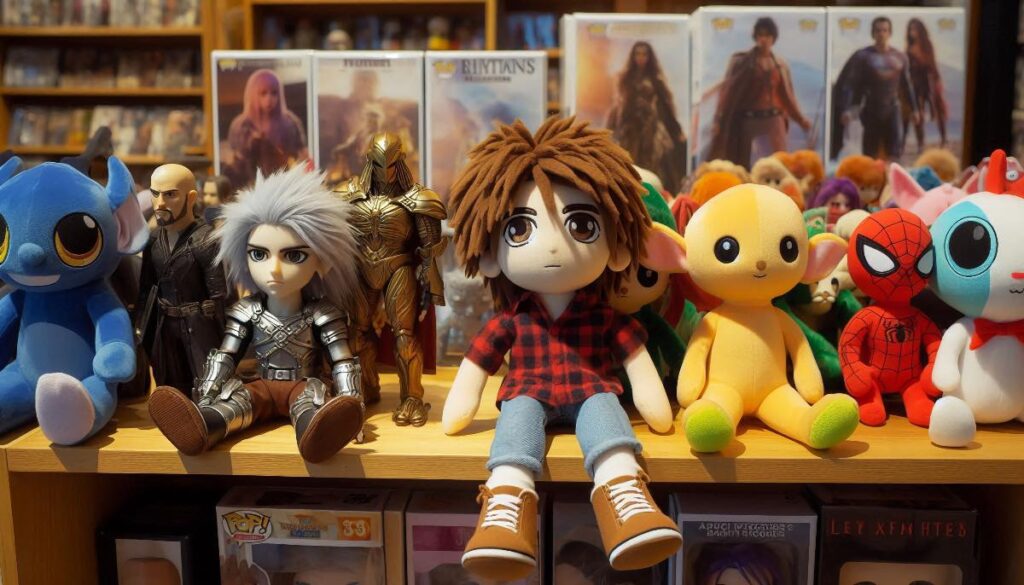Plushies
Plush Dolls and Action Figures: A Soft Revolution in Toy Culture
Table of Contents
Introduction
Plush toys have long held a cherished place in the hearts of children and collectors, offering not just entertainment but emotional connection and creativity. Among the many categories of these cuddly companions, plush dolls and action figures stand out for their unique ability to blend softness with character-driven storytelling. These toys bridge the gap between traditional comfort objects and dynamic imaginative play, making them a favorite across generations. For those seeking the best plush dolls and action figures, curated with quality, character, and creativity in mind, this collection offers something for everyone — from imaginative kids to plush toy enthusiasts and seasoned collectors.
Whether you’re looking to buy plush dolls for children or purchase soft action figures that capture the essence of beloved characters, this guide will help you explore your options with confidence. From their developmental benefits to safety tips and buying advice, we’ll cover everything you need to know about these versatile toys.
As the toy industry evolves, plush dolls and action figures are becoming more diverse, customizable, and educational, supporting everything from role-play and emotional growth to fine motor development (Ginsburg, 2007). Whether they’re superheroes, fantasy icons, or soft representations of real-life people, these toys continue to play an essential role in childhood and beyond.
Plush Dolls
Benefits of Plush Dolls
Plush dolls do more than just look adorable — they serve as vital tools in a child’s emotional and social development. These soft companions encourage imaginative play, helping children create stories, explore roles, and build narrative thinking. Through make-believe, children begin to understand empathy, problem-solving, and self-expression (Singer & Singer, 1990).
Emotionally, plush dolls act as transitional objects — they bring comfort during bedtime, travel, or unfamiliar experiences. They often become a child’s confidant, providing a sense of security that supports mental well-being and resilience (Winnicott, 1953). Additionally, caring for a plush doll nurtures a child’s sense of responsibility and empathy, laying a foundation for compassionate behavior in real-life relationships.
Whether it’s a soft baby doll, an animal-inspired friend, or a culturally representative character, plush dolls reflect diversity, imagination, and warmth, making them cherished companions throughout childhood and even into adulthood.
Buying Plush Dolls for Children
When planning to buy plush dolls for children, consider their age, developmental needs, and personal interests. For infants and toddlers, choose dolls made with ultra-soft fabrics and embroidered features for safety. As children grow older, opt for more detailed designs that match their imagination and interests — such as dolls based on storybook characters, superheroes, or cultural figures.
Look for dolls that are durable, machine washable, and certified safe for your child’s age group. Materials like organic cotton or hypoallergenic fillers can offer extra reassurance for parents concerned about allergies or sensitivities. Bonus features like removable outfits or accessories can add replay value and stimulate fine motor skills through dressing and undressing the doll (Ginsburg, 2007).
Today’s plush dolls come in a wide range of styles — from gender-neutral designs to inclusive dolls that represent different races, abilities, and identities. By thoughtfully selecting a plush doll, you’re not just giving a toy — you’re offering a tool for growth, imagination, and emotional bonding.
Plush Action Figures
Features of Plush Action Figures
Plush action figures blend the softness of traditional plush toys with the dynamic elements of action figures, offering a unique hybrid that appeals to both children and collectors. These toys often feature poseable limbs, removable accessories, or character-specific costumes, allowing for imaginative roleplay and storytelling. Their soft construction makes them suitable even for younger children, providing the excitement of a hero figure without the rigidity or sharp parts of plastic versions.
Many plush action figures are modeled after popular characters from movies, TV shows, anime, and video games — making them especially desirable for fans who want a cuddly version of their favorite icon. Thanks to their creative designs, these toys promote not just imaginative play but also emotional attachment, as children integrate beloved characters into their everyday lives.
Additionally, some plush action figures incorporate interactive features, such as sound chips, lights, or magnetic components, enhancing the play experience and deepening engagement. These features can foster cognitive development and help children make sense of cause-and-effect relationships in an enjoyable way,
Purchasing Plush Action Figures
When looking to purchase plush action figures, it’s important to assess quality, safety, and authenticity. Trusted manufacturers often offer officially licensed merchandise that meets child safety standards and exhibits superior durability. Stitching, detailing, and fabric quality are all indicators of a figure that will withstand frequent play while retaining its charm.
Collectors may want to explore limited edition releases, character crossovers, or plush figures tied to specific events or anniversaries. These tend to hold higher collectible value and often include unique design features or packaging.
Parents shopping for children should check age recommendations and prioritize toys that are machine washable, non-toxic, and free of detachable parts for young users. Online marketplaces, specialty toy retailers, and fan convention shops offer a broad range of plush action figures, with reviews often serving as helpful guides to ensure you’re getting a figure that’s worth the investment.
Where to Shop for Soft Dolls and Action Figures
Where to Shop for Soft Dolls and Action Figures
Finding the perfect plush dolls and action figures can be an enjoyable and meaningful experience, particularly when choosing a retailer that prioritizes craftsmanship, quality, and imaginative design. Whether the toys are intended for children, collectors, or gift-givers, selecting a trusted vendor can make a significant difference in both satisfaction and product longevity.
While large online marketplaces may offer broad selections, specialty retailers that focus exclusively on plush toys often provide a more curated and memorable experience. This particular store emphasizes original designs, safe and soft materials, and limited-edition collections that appeal to a range of age groups and tastes. By offering detailed product descriptions, thoughtful categorization, and attentive customer support, the store creates an experience that extends beyond the transaction — aiming to deliver lasting joy with every purchase.
For those seeking unique plush dolls or collectible action figures, this approach ensures not only a high-quality product but also a more personal connection to the item itself — one rooted in creativity, comfort, and delight.
For shoppers who prefer a hands-on experience, brick-and-mortar toy stores and specialty boutiques offer the advantage of physically inspecting the plush dolls and action figures before purchasing. This can be especially useful when checking for stitching quality, softness, or poseability. Local stores may also offer personalized recommendations, which are particularly helpful for gift buying or first-time shoppers.
Additionally, fan conventions and pop culture expos are increasingly popular venues to discover rare or themed plush action figures. These events often feature limited releases, artist-made items, and merchandise tied to specific fandoms. Some even allow you to speak directly with creators or designers, making it a more immersive shopping experience.
No matter where you shop, look for secure return policies, clear product descriptions, and age-appropriate labeling to ensure a safe and satisfying purchase. Reputable vendors also tend to offer guarantees or certifications that verify the authenticity and safety of their toys — especially important when buying plush dolls and action figures for younger children.
Conclusion
Plush dolls and action figures are more than just toys — they are emotional touchstones that enrich childhood, enhance storytelling, and offer comfort across generations. Whether you’re buying a huggable soft doll for a toddler or collecting a plush action figure based on a beloved comic book hero, these toys serve as powerful tools for both development and expression.
The magic of plush dolls lies in their nurturing qualities — they often become cherished companions that children talk to, sleep with, and confide in. At the same time, plush action figures invite adventure and creativity, allowing kids to invent daring missions, imaginary worlds, and endless narratives. Together, they foster cognitive flexibility, emotional security, and creative thinking — key elements of healthy childhood development (Piaget, 1962; Wiles & Hart, 2021).
Collectors, too, find immense value in these toys. For many, plush toys provide nostalgia, fandom pride, or even artistic appreciation — especially when it comes to limited-edition designs or hand-crafted features. These items can become meaningful keepsakes, heirlooms, or display-worthy pieces that reflect personal identity and interests.
Ultimately, whether you’re buying plush dolls for children, purchasing plush action figures, or shopping for soft dolls and action figures to add to a growing collection, the joy they bring is universal. Their lasting appeal is a testament to the way these cuddly characters connect us to memories, imagination, and each other — no batteries or screens required.
References
Brown, S. (2009). Play: How it shapes the brain, opens the imagination, and invigorates the soul. Avery.
Ginsburg, K. R. (2007). The importance of play in promoting healthy child development and maintaining strong parent-child bonds. Pediatrics, 119(1), 182–191.
Piaget, J. (1962). Play, dreams and imitation in childhood. Routledge.
Singer, D. G., & Singer, J. L. (1990). The house of make-believe: Children’s play and the developing imagination. Harvard University Press.
Winnicott, D. W. (1953). Transitional objects and transitional phenomena. International Journal of Psychoanalysis, 34, 89–97.
Wiles, M., & Hart, L. (2021). The psychology of pretend play: Implications for educational toy design. Child Development Perspectives, 15(2), 88–94.


